
Hoddesdon is a town in the Broxbourne borough of the English county of Hertfordshire, situated in the Lea Valley. It grew up as a coaching stop on the route between Cambridge and London. It is located 3 miles (5 km) West of Harlow 4 miles (6 km) southeast of Hertford, 5 miles (8 km) north of Waltham Cross and 11 miles (18 km) southwest of Bishop's Stortford. At its height during the 18th century, more than 35 coaches a day passed through the town. It saw a boom in the mid 20th century as gravel was extracted from the area, but was exhausted by the 1970s. The lakes and water pits left behind have been used as leisure amenities. Today, Hoddesdon has a little light industry but is mainly a London commuter belt town. The town hosted the eighth Congrès International d'Architecture Moderne in 1951. It is twinned with the Belgian city of Dinant.
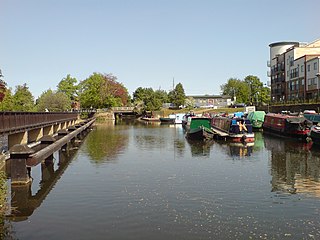
The River Lea is in South East England. It originates in Bedfordshire, in the Chiltern Hills, and flows southeast through Hertfordshire, along the Essex border and into Greater London, to meet the River Thames at Bow Creek. It is one of the largest rivers in London and the easternmost major tributary of the Thames.
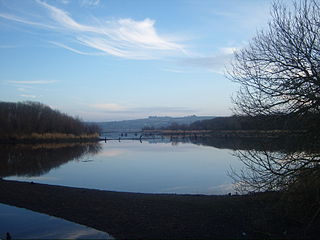
The River Lee is a river in Ireland. It rises in the Shehy Mountains on the western border of County Cork and flows eastwards through Cork, where it splits in two for a short distance, creating an island on which Cork's city centre is built, then passing through Cork Harbour on the south coast, one of the largest natural harbours in the world, to empty into the Celtic Sea. The catchment area of the River Lee is 1,253 km2. The long-term average flow rate of the River Lee is 40.4 cubic metres per second (m3/s)

Lee Valley Regional Park is a 10,000-acre (40 km2) 26 miles (42 km) long linear park, much of it green spaces, running through the northeast of Greater London, Essex and Hertfordshire from the River Thames to Ware, through areas such as Stratford, Clapton, Tottenham, Enfield, Walthamstow, Cheshunt, Broxbourne and Hoddesdon in an area generally known as the Lea Valley. Greater London's largest park, Lee Valley Park is more than four times the size of Richmond Park, extending beyond Greater London's borders into the neighbouring counties of Hertfordshire and Essex.

The Prescott Channel was built in 1930–35 as part of a flood relief scheme for the River Lee Navigation in the East End of London, England, and was named after Sir William Prescott, the then chairman of the Lee Conservancy Board. Rubble from the demolished Euston Arch was used in 1962 to improve the channel, which forms part of the Bow Back Rivers.

Dobbs Weir is both a weir in Hoddesdon, Hertfordshire and an area of Roydon, Essex in England on the River Lea. It is well known for angling, outdoor beauty and watersports. It is overlooked by the Fish and Eels pub.

Hertford Castle Weir is a weir located in Hertford near to Hertford Castle and next to Hertford Theatre.
Rye House Stadium is a former greyhound racing and current speedway venue in Rye House near Hoddesdon, Hertfordshire. It is situated adjacent to the River Lea Navigation.

The Lea Valley Walk is a 50-mile (80 km) long-distance path located between Leagrave, the source of the River Lea near Luton, and the Thames, at Limehouse Basin, Limehouse, east London. From its source much of the walk is rural. At Hertford the path follows the towpath of the River Lee Navigation, and it becomes increasingly urbanised as it approaches London. The walk was opened in 1993 and is waymarked throughout using a swan logo.
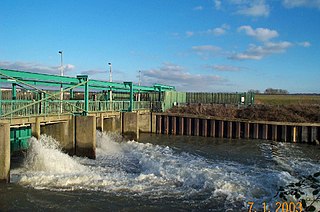
The Lee Flood Relief Channel (FRC) is located in the Lea Valley and flows between Ware, Hertfordshire, and Stratford, east London. Work started on the channel in 1947 following major flooding and it was fully operational by 1976. The channel incorporates existing watercourses, lakes, and new channels. Water from the channel feeds the Lee Valley Reservoir Chain.

Old Ford Lock is a paired lock and weir on the River Lee Navigation, in the London Borough of Tower Hamlets, England. It is at Fish Island in Old Ford and takes its name from the natural ford which used to cross the River Lea.

Fishers Green is a settlement 1 mile (1.6 km) to the north of the town of Waltham Abbey, Essex, England, in the parish of Waltham Abbey. It lies on the flood plain of the River Lea.
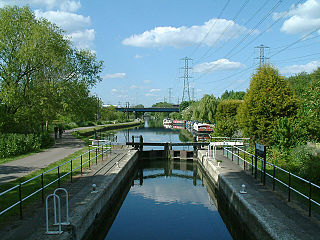
Rammey Marsh Lock is a lock on the River Lee Navigation at Enfield, London, England. The area adjacent to the lock is known as Rammey Marsh and close to the River Lee Flood Relief Channel.

Dobbs Weir Lock is a lock on the River Lee Navigation near Hoddesdon.

Feildes Weir Lock (No5) is a lock on the River Lee Navigation located close to Hoddesdon.

Hardmead Lock (No3) is a lock on the River Lee Navigation at Great Amwell close to the town of Ware.

Three Mills Wall River Weir is a weir on the Bow Back Rivers, in Mill Meads in the London Borough of Newham, England, near to Three Mills. It was built in 2009, when the Bow Back Rivers were refurbished to make them a key feature of the Queen Elizabeth Olympic Park, and maintains water levels through much of the park in conjunction with the Three Mills Lock and sluice on the Prescott Channel.

The Cornmill Stream is a minor tributary of the River Lea in the English county of Essex.

Rye House in Hoddesdon, Hertfordshire is a former fortified manor house, located in what is now the Lee Valley Regional Park. The gatehouse is the only surviving part of the structure and is a Grade I listed building. The house gave its name to the Rye House Plot, an assassination attempt of 1683 that was a violent consequence of the Exclusion Crisis in British politics at the end of the 1670s.
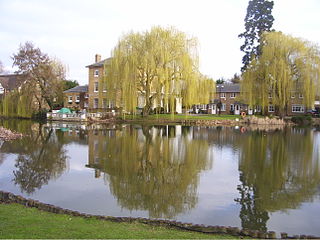
The River Lynch, also known as the Lynch Brook, is a minor tributary of the River Lea in Hoddesdon, Hertfordshire, England.





















